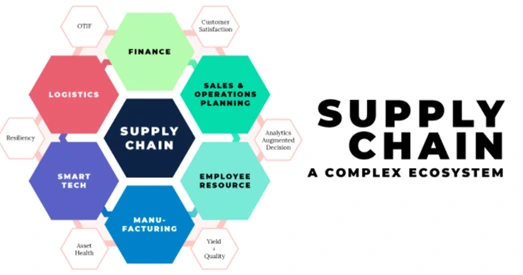Supply chain management is an essential process and plays a critical role in the emerging world market. To stay competitive, organizations need to evaluate their supply chains thoroughly and fix any loopholes.
The supply chain may seem alright, but a close inspection always helps and shows the bottleneck areas. Even a minor inadequacy in the initial planning stages can have a substantial impact on ROI later on. The faster an organization knows what's functioning well and what's not, the better its chances to tackle it on time.
Supply chains are prone to many disturbances and happenings as they operate in different markets, sometimes simultaneously.
Supply chains are governed by external and internal factors resulting from various inter-departmental processes within an organization. This dependency and vulnerability to internal and external ecosystems make global, national, and local supply chains complex. Any slight change in the chains can have a cascading effect on the entire ecosystem.
Volatile markets and concerns like Covid -19 pandemics, which have caused a landslide shift in the way markets are working, have led business leaders to rely on and invest more in Business Intelligence and data analytics.
Armed with the right data analytics, companies can form business strategies and accordingly rewire their supply chains and attain success irrespective of the stability and economic downturns that keep happening in the market.
Business Intelligence-led supply chains are proving to be efficient, reducing delivery times, providing cost savings, and allowing organizations to control market conditions.
Challenges that Supply Chains Face and the potential for BI
The supply chain is fraught with challenges due to market demand and supply gaps, market volatility, transportation, rules and regulations, and many more, right from sourcing to manufacturing to warehousing and delivery. These challenges also affect cost control, planning, forecasting,vendor-client relationships, and consumer demands.
Demand Instability
Companies either overproduce or underproduce, as they do not have sufficient information on real-time market demand. Demand for essential items, lack of resources, economic dips, natural disasters, competitors all can affect the supply chain and impact the overall business growth. To overcome this, organizations are opening up to the possibilities of predictive analytics to steer clear of the roadblocks.Impediments to the sourcing to warehousing chain
The supply chain has to be efficient and productive, ensure sourcing of quality maintenance from suppliers, getting the raw materials in time for manufacturing, and then transporting to the warehouse inventory management, and coordinate for the last mile delivery.These are all cost-incurring parameters, and here BI can play a huge role in keeping costs under control and improve revenues.BI can equip the supply chain managers with strategies to obtain cost-effective materials, restructure manufacturing processes, place the material in the most accessible warehouse, and maintain the ideal inventory to prevent overheads or idle inventory.
Distribution and Communication Challenges
Distribution involves the whole range of packing activities, inventory, warehousing, logistics, and movement from one place to another. There has to be a constant track of the movement of the material and real-time status updates, which is critical to successfully implementing the supply chain to guarantee a flawless outcome.
With BI, companies can easily track and monitor the real-time status of the orders and keep the customers in the loop.
Transport Hurdles
Organizations are constantly seeking cheaper and more sustainable means of transportation, optimum route planning, and vehicles in compliance with all the rules and regulations.Data analytics is automating this manual search process and making it faster and more efficient while providing new suggestions.BI is assisting with projections on costs of transportation, better fuel, and route optimization, lower costs of transportation, and in the future, may offer AI-guided vehicular options too.
Adequate and timely investment in building the supply chain data analytics infrastructure can help companies forecast and minimize any risks or challenges.
Supply Chain and Analytics
Organizations apply supply chain analytics to forecast demand shifts, effectively manage resources, lessen potential risks, and enhance the efficiency of the supply chain from source to destination.
An organization has to be reactive to the rapid shifts in the markets. For an organization to be proactive, it has to understand and analyze the data from all the various functions involved in the supply chain ecosystem.
Optimizing Supply Chain with Business Intelligence
Business intelligence (BI) helps you recognize and forecast risks that could affect your business and enable managers to take pre-emptive, corrective action.
BI provides the insights required to rectify any anomalies by analyzing the data in an organized and structured way. To optimize enduring and winning business performance, organizations must balance all the business's goals simultaneously.
The probability that while a company has a hold over one process, it might be lacking in another. Business intelligence can help by providing the design and architecture to know that every function is in sync.
Business Intelligence will enable a business to calculate their required order percentage to fulfill the demand. Now, the numbers are there, but it cannot make the people work to execute it. So, the management can take concrete steps now to enhance the performance and fulfill it.
Evaluating landed costs may seem simple, but considerations like material procurement, production, and logistics cost only provide incomplete input. Organizations have to allocate overheads and rejig costs that are in tune with the business goals. The aim is not to undertake accounting management but to arrive at the best cost decisions related to the inventor.
The aim is not to undertake accounting management but to arrive at the best cost decisions related to inventory management, logistics network, material acquisition, and even outsourcing considerations.
Why does SCM need Business Intelligence?
- BI helps monitor internal and external conditions and provides the metrics and data to take remedial actions.
- Business Intelligence provides detailed parameters with Key Performance Indicators.
- Helps assess monthly and quarterly goals and forecast demand and supply gaps.
- Business Intelligence can integrate and assimilate all the data across many departments to offer a bird's eye view.
- Business Intelligence enables detailed data from every step of the chain and allows management to tackle any loopholes effectively and in real-time.
The Future of Supply Chain Business Intelligence:
The future of the supply chain belongs to the companies that implement a Business Intelligence Analytics strategy. BI implementation will ensure the equality of data and analytics, the automation of business processes, and the upskilling of people to be prepared and competitive.
The robustness of the supply chain will lean heavily on easy data access and automated processes at every step to be proactive and responsive to market volatility and reduce risks. Lack of timely data and information leads to improper planning, delayed action, and bad decisions that can cost companies.
With the entry of new technologies and business processes, people will have to be upskilled and trained. This will take place across the supply chain ecosystem, at every level of the hierarchy. Staff will have to be trained on managing and evaluating the data critically to improve forecasting abilities and decision-making across all supply chain levels and roles.
Acumen and Vision may very well describe the powers that Business Intelligence can bestow upon organizations. By getting insights into the details involved in the details, organizations are much better equipped to make transformations and strategic changes that change the supply chain dynamics to a more agile and profitable one through real-time interventions.
The results are enhanced supply chain efficiencies, cost reductions, and more streamlined operations. There are no guarantees, but by implementing the right Business Analytics process, organizations can start on the path to implementing the right tools and measures today to gain a competitive edge and be prepared to tackle the contingencies that may crop up down the road.



Let's Discuss Your Idea.!
Whether you have a question for our team, want to chat about your project ideas, or are curious about our expertise, please send us your request using the form below.
Contact Info
Our contacts